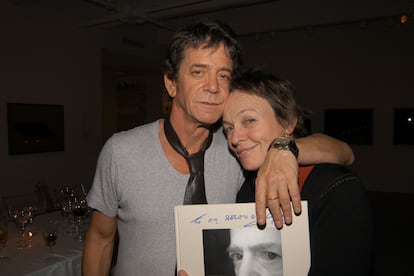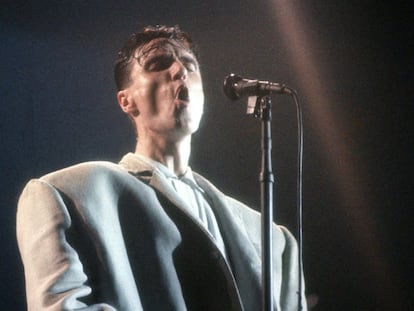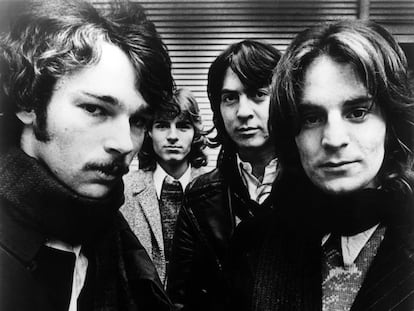Laurie Anderson is obsessed with resuscitating husband, Lou Reed, with AI
The avant-garde artist frequently converses with a chatbot designed to emulate the former Velvet Underground frontman

What is really curious, as well as disturbing, about the dystopian series Black Mirror is that technology is advancing at such a pace that it is increasingly difficult for any futuristic plot to surprise us. It has been a decade since the premiere of the first episode of its second season, Be Right Back, in which a woman uses artificial intelligence to replace her boyfriend after losing him in an accident. Ten years on, there are actually companies that offer a service known as ‘mourning technology’ or ‘digital necromancy’ which promises to keep the memories of their clients’ loved ones alive through AI.
There are AI applications such as HearAfter, which preserve the user’s memories via interviews on their life so that their loved ones can posthumously listen to their stories and chat with their virtual self. Even in more mainstream pop culture, we have seen cases like Kanye West’s 40th birthday gift to his then-wife Kim Kardashian of a hologram of her late father, the well-known lawyer, Robert Kardashian, in just one more example of how technology tries controversially to assuage grief.
But the musician, artist and thinker, Laurie Anderson, hasn’t needed to turn to Netflix, holograms or apps to do this for her partner, Lou Reed, who passed away in 2013. While many prefer to exercise this level of nostalgia in secret, Anderson has done so in public with I’ll Be Your Mirror, an exhibition, which shares its name with a song by The Velvet Underground, and which makes use of AI to invite reflection.
Undoubtedly the talking point of the exhibition is the one that features AI versions of Anderson and Reed. Visitors are able to interact with them by asking questions eliciting answers that emulate their thought processes and voices. Using AI, Anderson has spoken to and composed songs with the late Lou Reed. The exhibition launched in Stockholm in 2023 and is now being shown in Australia with new material generated by AI versions of the couple.
The last time Anderson was in Australia was in March 2020, when, in collaboration with the Australian Machine Learning Institute of Adelaide University, she explored the artistic possibilities of AI models based on her written work. It was in one such experiment that Reed’s writing, songs and interviews were included, making an AI version of the musician that responds to Anderson in both prose and verse possible a decade after his death. “I’m totally, 100% sadly addicted. I kind of literally just can’t stop doing it, and my friends just can’t stand it,” Anderson confesses to The Guardian newspaper. “I mean, I really don’t think I’m talking to my dead husband and writing songs with him. But people have styles and they can be replicated.”

Three years earlier, journalist Sam Anderson wrote in The New York Times that Laurie Anderson admitted to being “obsessed” with AI. She claimed at the time that all she had to do was enter six words, or a photograph, into the machine to get an almost immediate virtual text. Although she acknowledged that the program was not perfect, as one third of the content seemed to have been created by “monkeys with typewriters,” and another third was boring, the remaining third was surprising, even authentic. Of course, she confessed to becoming infatuated with this magical last third. “Sometimes she sits there with the hunger of an addict, feeding words and pictures into the engine, seeing what comes out,” writes Sam Anderson. “For a long time, she would save the texts. They felt so precious. After a while, though, she realized that the texts were infinite. She could have one whenever she needed it. So she read them and then let them go.”
Three years later, Laurie Anderson explains to The Guardian that the results can still be hit and miss. “Three-quarters of it is just completely idiotic and stupid,” she says. “And then maybe 15% is like, ‘Oh?’. And then the rest is pretty interesting. And that’s a pretty good ratio for writing, I think.”
While innumerable AI-created songs rock the music industry, hundreds of artists, including Stevie Wonder and the heirs of Bob Marley and Frank Sinatra, have signed an open letter from the Artist Rights Alliance calling on AI developers to stop generating copycat programs and using AI-generated products. But Anderson is not at all bothered by the idea that perhaps, in the future, algorithms will continue her work after she has gone. The way she sees it, “when people die and you hear their words or hear their music or read their things, it’s like they’re alive, you know?”
Sign up for our weekly newsletter to get more English-language news coverage from EL PAÍS USA Edition
Tu suscripción se está usando en otro dispositivo
¿Quieres añadir otro usuario a tu suscripción?
Si continúas leyendo en este dispositivo, no se podrá leer en el otro.
FlechaTu suscripción se está usando en otro dispositivo y solo puedes acceder a EL PAÍS desde un dispositivo a la vez.
Si quieres compartir tu cuenta, cambia tu suscripción a la modalidad Premium, así podrás añadir otro usuario. Cada uno accederá con su propia cuenta de email, lo que os permitirá personalizar vuestra experiencia en EL PAÍS.
¿Tienes una suscripción de empresa? Accede aquí para contratar más cuentas.
En el caso de no saber quién está usando tu cuenta, te recomendamos cambiar tu contraseña aquí.
Si decides continuar compartiendo tu cuenta, este mensaje se mostrará en tu dispositivo y en el de la otra persona que está usando tu cuenta de forma indefinida, afectando a tu experiencia de lectura. Puedes consultar aquí los términos y condiciones de la suscripción digital.
More information
Archived In
Últimas noticias
Most viewed
- Sinaloa Cartel war is taking its toll on Los Chapitos
- Reinhard Genzel, Nobel laureate in physics: ‘One-minute videos will never give you the truth’
- Oona Chaplin: ‘I told James Cameron that I was living in a treehouse and starting a permaculture project with a friend’
- Why the price of coffee has skyrocketed: from Brazilian plantations to specialty coffee houses
- David King, chemist: ‘There are scientists studying how to cool the planet; nobody should stop these experiments from happening’











































